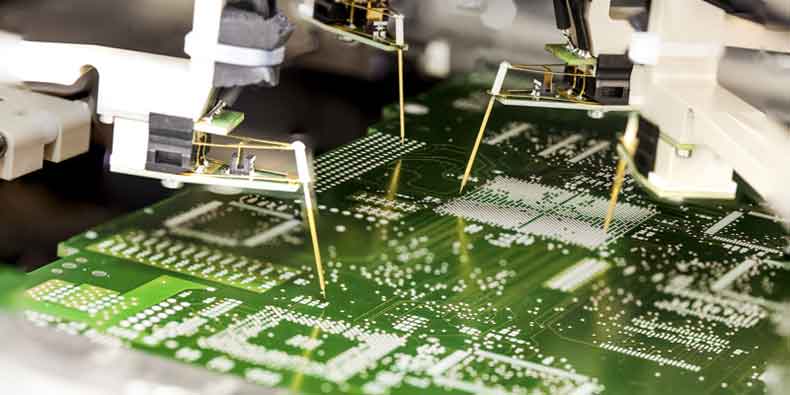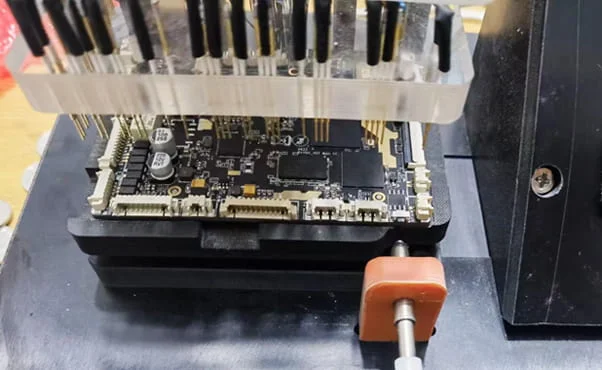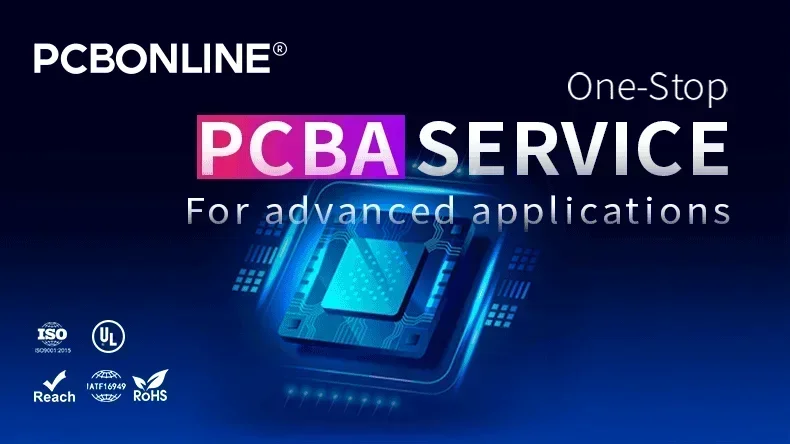When it comes to printed circuit boards (PCBs), quality and reliability are critical. For small-batch or prototype PCB orders, a flying probe test is an accurate, flexible, and cost-effective testing method. Unlike an in-circuit test (ICT), flying probe testing does not require custom fixtures. Therefore, a flying probe test is the best choice for ensuring quality in small and medium PCB production runs.
In this article by PCBONLINE, an advanced PCB manufacturer, we will explain how the flying probe test works, compare its cost with ICT, and discuss why it is the ideal method for small-batch PCBs.
Part 1. What is a Flying Probe Test and How Does It Work?
A flying probe test is an automated electrical testing method used on bare PCBs after the PCB board is fabricated. It is designed to check whether all electrical connections are correct and whether there are any open circuits, short circuits, or assembly defects.
How a PCB fly probe test works
Test program generation – CAD data and the PCB's netlist are loaded into the system, defining where and what to test.
Probe positioning – The flying probe tester controls multiple probes (commonly 2 to 8), each capable of moving in the X-Y plane with high accuracy.
Electrical testing – The probes touch specific test points in sequence. Small voltages or currents are applied, and the resulting electrical responses are measured.
- If the resistance is near zero between two points, the circuit is connected.
- If resistance is infinite, the circuit is open.
- If unintended connections exist, a short circuit is detected.
Additional component checks – For assembled PCBs, the system can measure values of resistors, capacitors, diodes, and sometimes even verify polarity or orientation.

A flying probe tester can handle PCBs with fine-pitch components, high-density layouts, and frequent design changes without additional hardware investment.
Part 2. Flying Probe Cost vs In-Circuit Test
When deciding between a flying probe and ICT, cost is usually the biggest factor.
Flying probe test cost
- No fixture cost. Probes are programmed to move according to CAD/netlist data.
- Low setup cost. Perfect for prototypes, engineering samples, and small batches.
- Test time is longer because probes move sequentially, which slightly increases per-board cost.
In-circuit test (ICT) cost
- High fixture cost. Custom bed-of-nails fixtures must be manufactured for each PCB design, costing thousands of dollars.
- High setup cost, but low per-unit test cost. Once the fixture is ready, testing is very fast and suitable for high-volume production.
- Less flexible. If the PCB design changes, a new fixture must be built.

In short, a flying probe test is more cost-effective for small to medium runs. By contrast, an ICT is cheaper per unit for mass production after the upfront fixture investment.
Part 3. Why is Flying Probe Test Suitable for Small-Batch PCBs?
We consider that a flying probe test is good for small-batch PCB quality assurance. The reasons are below.
- No fixture requirement – Without the need to build custom fixtures, manufacturers can begin testing immediately after programming. This reduces lead time and upfront expenses.
- Flexibility with frequent design changes – During prototyping and early product development, designs may change multiple times. Flying probe testing allows manufacturers to adapt quickly by updating software instead of remanufacturing hardware fixtures.
- High test coverage – The probes can reach test points that may be inaccessible to ICT fixtures, making it ideal for high-density, fine-pitch PCBs.
- Lower cost for small runs – Since there is no fixture to amortize, the per-board cost is lower for small batches, even if the actual testing process takes slightly longer.
- Fast prototyping feedback – Engineers receive accurate test results quickly, which accelerates product development cycles and ensures design reliability before scaling up.
Flying probe testing strikes the perfect balance between cost, accuracy, and flexibility for prototypes, pilot runs, and low-to-medium volume PCB production.
Part 4. Partner with PCBONLINE for High-Quality PCB Manufacturing
Looking for a professional PCB manufacturer that handles all the tests and electronics manufacturing for your project? You can work with the turnkey PCB manufacturer, PCBONLINE, from one-stop PCB manufacturing and value-added services until you receive the high-quality products.

Founded in 2005, PCBONLINE has two large advanced PCB manufacturing bases for PCB fabrication, one turnkey PCB assembly factory for turnkey PCB assembly and box-build assembly, stable material supply chains, and strategic cooperation with electronic component manufacturers, and long-term cooperation with the top 3 mold and enclosure manufacturers in China for PCBA test fixtures, molds, and enclosures.
Besides, PCBONLINE has an R&D team and professional CAM engineers for project development and DFM, including PCBA test designs.
We offer both flying probe testing and ICT, depending on your batch size and requirements.
Complete PCBA test equipment and capabilities for PCB manufacturing, PCB assembly, and post-assembly, such as the AOI, flying probe test, ICT, X-ray, thermal shock, impedance, cross-section analysis, button strike, four-terminal sensing, tension, bending, high-voltage, heat transfer, functional, programming, burn-in, and application test.
Our engineers can provide design-for-manufacturing (DFM) and design-for-testability (DFT) reviews to ensure the highest yield.
Provides one-on-one free and professional DFM for PCB, PCBA, and box-builds before and during prototyping/sampling, including checking the test files, to ensure the manufacturability and project success.
High-quality PCB manufacturing certified with ISO 9001:2015, ISO 14001:2015, IATF 16949:2016, RoHS, REACH, UL, and IPC-A-600 Class 2/3.
PCBONLINE can design the test points for your PCB and offer improvement suggestions for your PCB design if there are any problems.
By partnering with PCBONLINE, you can guarantee that your small-batch PCBs are thoroughly tested with flying probe, minimizing risks and ensuring reliability before moving to our larger-scale production. To get a quote from the OEM PCB manufacturer PCBONLINE, contact info@pcbonline.com.
Conclusion
The flying probe test is a flexible, accurate, and cost-effective electrical test for verifying PCB quality in prototypes and small-batch production. It eliminates the need for costly fixtures. To ensure the success of your PCB/PCBA projects, work with the OEM PCBA manufacturer PCBONLINE.
PCB fabrication at PCBONLINE.pdf




